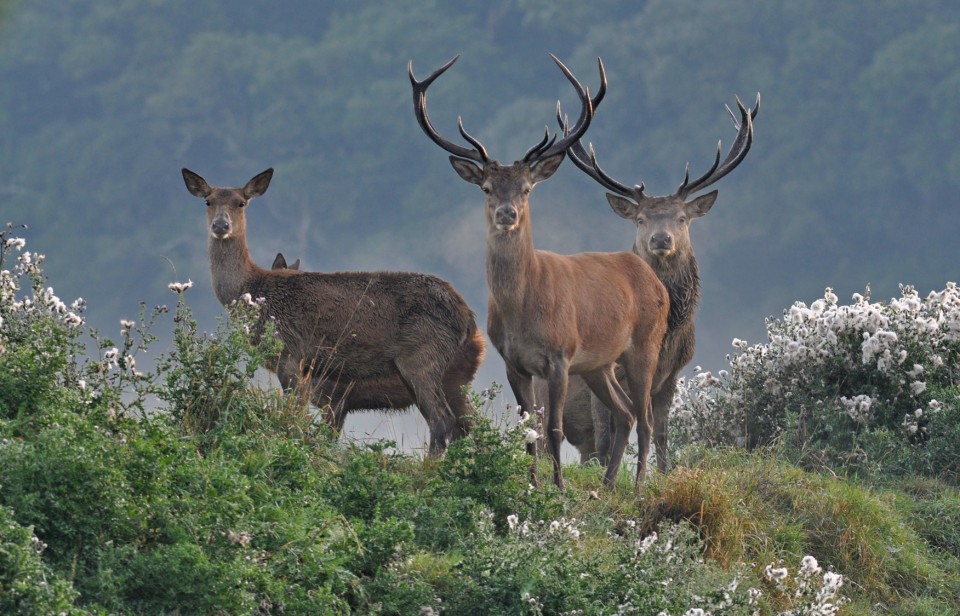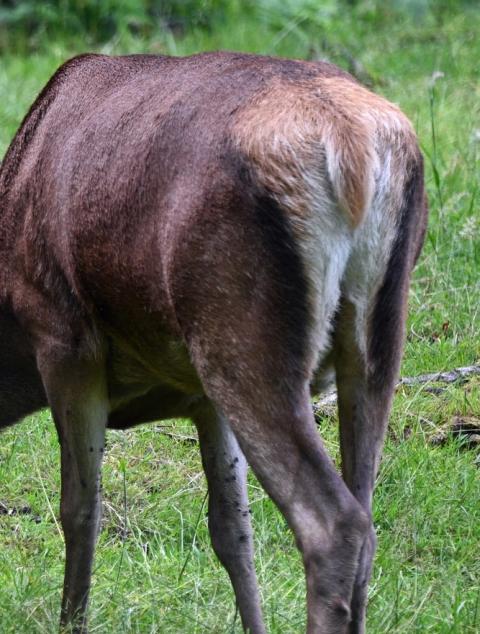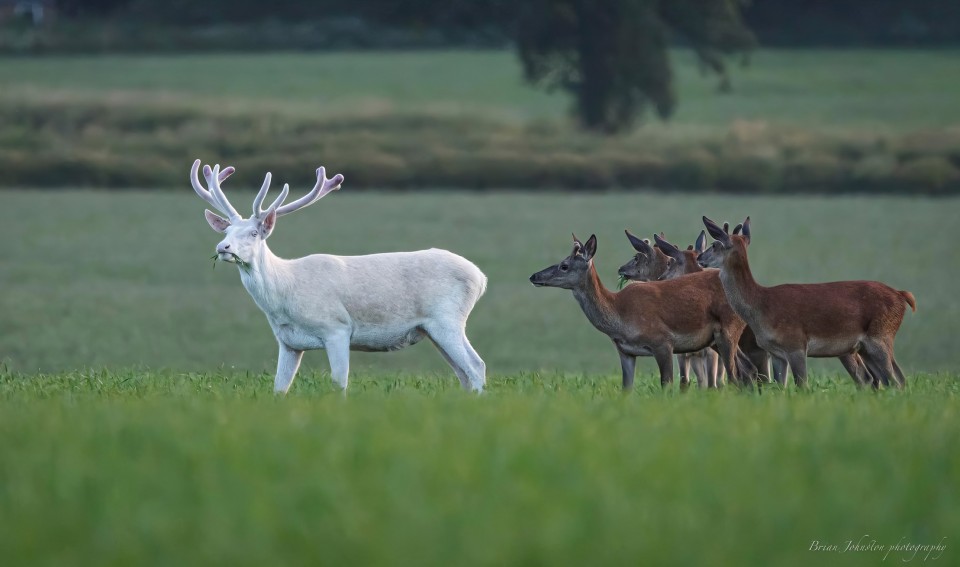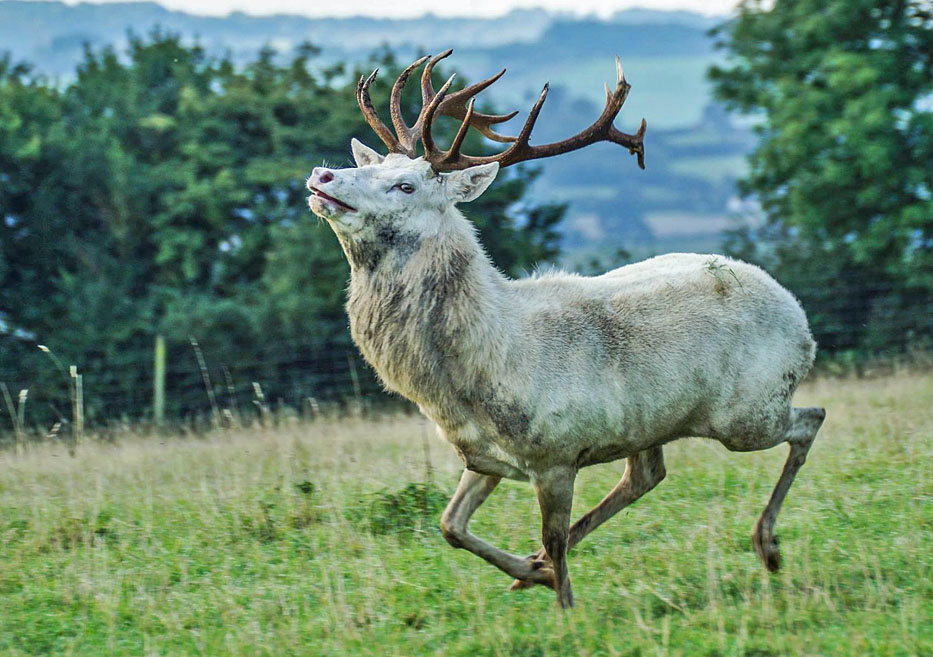Red Deer Appearance
Size & Weight
The following are generalised morphometrics for Red deer. As David Macdonald and Priscilla Barrett point out in their Field Guide to the Mammals of Britain and Europe, measurements of deer vary considerably according to habitat, population density and prevailing conditions. The mammologists also note that there is a distinct east-west cline, with animals in the east (e.g., in Scotland) being smaller than those in the west (e.g., North America), although if one subtracts the wapiti -- which aren't the same species -- the difference is more subtle. Indeed, writing in his Deer of the World, Valerius Geist considered this idea that Red deer and wapiti form a gradual cline to be unfounded. Overall, there is tremendous variation in size across their range, with deer living in poor habitats being stunted both in overall size and antler development. At the lower end of the size range is probably the Corsican Red deer, which typically weigh in at 80 kg (176 lbs), while those of the Carpathian Mountains sit at the other end of the scale, attaining weights of six-times this.

Adult Red deer in the UK and Europe are usually between 1.6 and 2.6 m (5.5 to 8.5 ft.) in length. A full-grown stag stands about 1.2 m (4ft) at the shoulder, while hinds are slightly smaller; about a metre at the shoulder. Both sexes possess a tail between 10 and 20 cm (4-8 in.) long. In the wild, adult Red stags generally weigh in at between 90 and 260 kg (200-570 lbs) depending upon the habitat, while hinds typically do not exceed 150 kg (330 lbs). Weight at any given time is highly dependent upon season and food availability, and a mature stag in prime condition (e.g., in a deer park or highly productive woodland) can weigh as much as 340 kg (750 lbs). Individuals from England, especially English parks and deciduous woodland, are often significantly larger than those on the impoverished hillsides and moorlands of Scotland. The reason for this size disparity seems to be related to the amount of food available during the crucial winter months, and explains why early attempts to improve the antler growth of Scottish stags by introducing park deer (see: Genetic Diversity and Hybridization) were largely unsuccessful. Indeed, a study by a team of biologists at the Rowett Research Institute in Aberdeen, published in the British Journal of Nutrition during 1983, (further details in Diet and Feeding behaviour) concluded:
"On Scottish hills deer reach a size appropriate to their environment rather than their genetic potential."
Colour

Red deer have a short summer coat, with little or no underwool, which starts to grow during May and is typically complete by late July or early August. The hair is a fairly consistent red-brown colour along its five centimetre or so (2 in.) length, giving the animal a rich red-brown colour. During September, a longer, coarser (hair is slightly corrugated) dull grey-brown winter coat starts to grow, and is complete by the end of the year. In their paper to the Journal of Zoology in 1973, the late sheep wool guru Michael Lawson Ryder and the late eminent Rowett Research Institute deer biologist Robin N.B. Kay described the winter coat as having long guard hairs of about 6 cm (2.4 in.) accompanied by a layer of underwool about two centimetres (1 in.) thick. Along its length, hairs of the winter coat change colour from pale brown at the base to very dark brown or black in the middle and light red-brown at the tip. Interestingly, citing Anthony Bubenik's work and a 1953 Russian paper by P.A. Merts, Kenneth Whitehead, in The Whitehead Encyclopedia of Deer, notes that, because the undercoat in stags grows after the rut, its density is dependent on the length of the rut (this affects body condition), and it may fail to develop at all in populations where a protracted rut leads to inadequate time to feed and recuperate before the first snows of winter arrive. Certainly, Tim Clutton-Brock and colleagues have observed that, on Rum, poor body condition of stags after the rut can delay the growth of the winter coat, resulting in heat loss that can potentially prove fatal in hard winters. Studies on captive herds kept under controlled photoperiods has demonstrated that the moult -- which starts on the face, neck and shoulders and proceeds along the back and down the flanks to the legs -- is controlled by the hormone melatonin secreted from the pineal gland. Body condition plays a significant role in hormone production, and moulting can therefore be an indicator of an animal's age and status. Non-breeding females and dominant stags tend to moult earlier than pregnant animals and stags in poorer condition, with calves and yearlings also moulting later. Animals in poor condition may experience a protracted moult.
The rump patch is a yellowish or cream colour, with a short beige-coloured tail. The rump patch colour varies tremendously in relation to geography, and this is a feature commonly used as a distinguishing feature of subspecies. Stags in some regions develop a mane during the autumn that's carried for the winter months (e.g., in Britain) and is typically slightly darker in colour than the rest of the coat; this may be accompanied by a dark stripe down the animal's back. The colour of the fur on the underside varies from off-white to yellowish or grey, and on a rutting stag it may be heavily stained with urine and mud that gives a dark brown or black appearance.
As is common for deer, newborn calves are spotted for the first few weeks of life, and these help camouflage it on the woodland floor. Spots are uncommon on adult coats, although on occasion adults have been observed with a double row of spots running down the back. Calves undergo two moults in their first year: the neonatal "pomeled" (spotted) coat is shed at about two months old, followed by the growth of the winter coat during the autumn.

Deviation from the typical colouration seem rare, although there can be geographic variation such that some populations (e.g., subspecies) may be darker or lighter than others. Non-albino white animals are reported more frequently, albeit in captive collections. In The Whitehead Encyclopaedia of Deer, for example, Kenneth Whitehead notes that white morphs deer have been preserved in deer parks; most notably Kinmonth in Perthshire, Charborough in Dorset, Woburn in Bedfordshire, and Zleby and Zehusice in Czechoslovakia. The late Sussex deer manager John Johnson told me that the small deer park at the Leonards Lee estate once had white Reds. Presumably, some of these herds are no longer present, because, to the best of my knowledge, the only herd of white Red deer recently held in the UK were at the South West Deer Rescue in Devon before it closed down in 2010. The origin of the gene for white pelage in captive populations is unknown, but thanks to the meticulous studies of Ludek Bartos we do know that the genetics of white Reds in Czechoslovakia is more complex than it is for white Fallow, being controlled by what geneticists refer to as three allelic pairs with dominant epistasis. Basically, there's about a 25% of progeny being white, because the red colouration is dominant over white. We also know that, unlike in Fallow deer where completely white herds can be maintained, this isn't possible in Reds - white Reds will often produce red calves, and normal coloured Reds can produce white calves. In his 1994 book, The Royal Stags of Winchester, Bruce Banwell described five different colour patterns: pure white, greyish, cream, white nose and hocks ("bald-faced"), and piebald. Banwell notes the "creamy" appearance is a result of gingery tips to the guard hairs, such that it't often only noticeable on close inspection and the individuals appear pure white at distance or in poor light, and that stags were more likely to be greyish or cream, while hinds were more likely to be pure white. Wildpark Eekholt park in Germany has several intriguing colour variants, including white with varying proportions of dark grey in the coat.
It seems that entirely or predominantly white individuals are very occasionally reported from the wild, including sightings in the Scottish deer forests, Scotland's Corrie Ba, and on the Quantocks in Devon. Indeed, Brian Johnston photographed what appears to be an albino stag in velvet on Exmoor in Devon during July 2024. There are also various legends, superstitions and stories involving white deer, most notably stags, including that of David I of Scotland, who was apparently almost killed by a white stag in 1128, and the legend of a young white stag befriended by locals on the Island of Arran off Scotland's west coast -- unfortunately, the stag became "too bold" and was eventually shot by the estate's Head Keeper in December 1970.
There are very occasional reports of melanism (very dark or black colouration) in Red deer. David Banwell mentioned melanism cropping up occasionally in deer parks, and I've seen one unconfirmed report from a deer farmer on New Zealand's North Island of a melanistic calf being born to a normal coloured hind. I'm aware of two apparently melanistic animals from the wild, both hinds and both from New Zealand. The first was a pregnant female carrying a normal coloured calf shot during September 2023. The second was a young individual, no greater than two years old, shot while feeding on crops on South Island in January 2021.

As alluded to by Banell, colour variations may also take the form of "bald-faced" or white-faced individuals, which exhibit white patches on their heads, varying in size from a small patch on the forehead to a large white band down the length of the face between the eyes, or even a completely white face; individuals may also have white "socks". Additionally, in their contribution to Mammals of the British Isles: Handbook, 4th Edition, Brian Staines, Jochen Langbein and Tim Burkitt mention that the summer coat is "sometimes whitish or skewbald [patches of white]", an observation also made by Whitehead.